
How Changing Reimbursement Models Will Impact Physicians
Lower fee-for-service rates and bundled payments may present challenges for physicians. So it's time to start planning today.
I recently visited an academic medical center where their faculty practice enjoyed commercial insurance reimbursements in excess of 300 percent of national Medicare levels. The chief operating officer expressed concern that if those rates dropped to 200 percent they would have survival issues. I suggested the question was not an "if" but a "when."
In previous posts, I discussed
Consumer Reports Health found that total hip replacement cost varies by 100 percent across the country. These costs ranged from less than $20,000 to more than $40,000 and included the cost of the surgeon, hospital, and anesthesia. Medicare, and a growing number of commercial plans, wants to pay a single amount, linked to an average market cost where outcomes are similar. Essentially the payer says that a "cure" should cost the same across the country except for minor fluctuations due to labor and other local costs.
If payers move in this direction, hospital costs and physician costs will be lumped together, perhaps including pre and post discharge costs (diagnostic studies, rehab, etc.) and a single payment will be made for the service. Hospitals, physicians, and others will need to decide how to split up that amount. Where services are purely outpatient, payments may be tied to the diagnosis, similar to the DRGs now paid to hospitals by Medicare. Physicians can see patients as often as they wish and order whatever studies they need but the payment is fixed.
This will become especially important in late 2013 when state insurance exchanges are activated. Under the Affordable Care Act, each state, or the federal government, will publish the rates for insurance plans available within the state that anyone, regardless of age or health, can purchase. Variations in cost within that state will impact the economics of the plans so they will be targets for standardization. Residents of a "high-cost, high-premium" state will be able to see the difference in their premium compared, perhaps, to a lower-cost neighboring state.
These changes will take place even if physicians are not part of some shared savings model, such as accountable care organizations (ACOs). Those physicians that can aggressively manage patients - essentially make them well with minimal effort - will prosper. Those that have patients return frequently, have more than normal complications, or who require more than average diagnostic support may not do as well. Physicians will have an incentive to utilize other clinical staff, such as nurse practitioners, educators, or specially trained registered nurses to help with patient management.
Those organizations that pay physicians based on work RVUs (wRVUs) or some other production formula not tied directly to cash in the door will need to rethink their models. Physicians in specialties with high cost procedures, such as orthopedics and cardiac surgery, will likely be faced with the issues around bundled payments. Physicians with a high number of chronically ill patients will need to address how best to manage those patients and avoid the high-cost complications that will become targets of payers.
The bottom line? Things are changing and it is best to start planning how to manage under those changes. My friend with the 300+ percent reimbursement will need to plan for future survival. Perhaps you aren’t in quite such a precarious position.
Newsletter
Optimize your practice with the Physicians Practice newsletter, offering management pearls, leadership tips, and business strategies tailored for practice administrators and physicians of any specialty.











